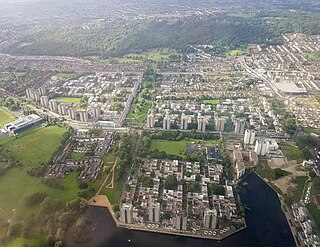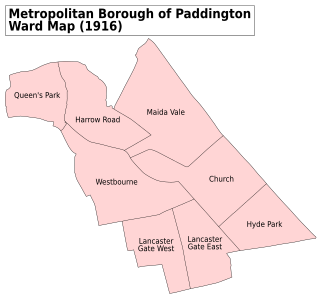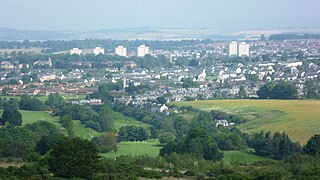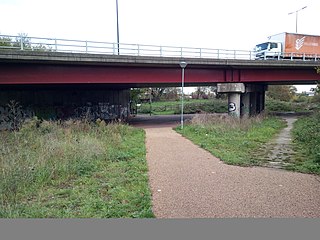
Thamesmead is an area of south-east London, England, straddling the border between the Royal Borough of Greenwich and the London Borough of Bexley. It is located 11 miles (18 km) east of Charing Cross, north-east of Woolwich and west of Erith. It mainly consists of social housing built from the mid-1960s onwards on former marshland on the south bank of the River Thames.

The London Borough of Bexley is a London borough in south-east London, forming part of Outer London. It has a population of 248,287. The main settlements are Sidcup, Erith, Bexleyheath, Crayford, Welling and Old Bexley. The London Borough of Bexley is within the Thames Gateway, an area designated as a national priority for urban regeneration. The local authority is Bexley London Borough Council.

Thames Gateway is a term applied to an area around the Thames Estuary in the context of discourse around regeneration and further urbanisation. The term was first coined by the UK government and applies to an area of land stretching 70 kilometres (43 mi) east from inner east and south-east London on both sides of the River Thames and the Thames Estuary. It stretches from Westferry in Tower Hamlets to the Isle of Sheppey/Southend-on-Sea and extends across three ceremonial counties.

Erith and Thamesmead is a constituency created in 1997 and represented in the House of Commons of the UK Parliament since 2019 by Abena Oppong-Asare of the Labour Party.

The Peabody Trust was founded in 1862 as the Peabody Donation Fund and now brands itself simply as Peabody. It is one of London's oldest and largest housing associations with around 55,000 properties across London and the South East. It is also a community benefit society and urban regeneration agency, a developer with a focus on regeneration, and a provider of an extensive range of community programmes.

Abbey Wood is an area in south east London, England, straddling the border between the Royal Borough of Greenwich and the London Borough of Bexley. It is located 10.6 miles (17 km) east of Charing Cross.

Broadwater Farm, often referred to simply as "The Farm", is an area in Tottenham, North London, straddling the River Moselle. The eastern half of the area is dominated by the Broadwater Farm Estate ("BWFE"), an experiment in high-density social housing, loosely based on Corbusian ideas, dominated by concrete towers connected by walkways, built in the late 1960s using cheap but fire-vulnerable pre-fabricated concrete panels. The western half of the area is taken up by Lordship Recreation Ground, one of north London's largest parks. Broadwater Farm in 2011 had a population of 4,844. The estate is owned by Haringey London Borough Council.

Westbourne is an area west of Paddington in west London. It has a manorial history spanning many centuries, within a more broadly defined Paddington, before shedding its association in the mid-19th century. It is named after the west bourne, West Bourne, or River Westbourne, a Thames tributary which was encased in 19th-century London in the 1850s. The spring-fed stream and associated manor have led to the place names Westbourne Green, Westbourne Park and more narrowly: Westbourne Gardens, Westbourne Grove, Westbourne Park Road, Westbourne Park tube station, Westbourne Studios and the name of a public house.

Burwood Park is an historic estate in the parish of Hersham in Surrey, England. The old mansion house has been demolished and much of the parkland built over to form approximately 400 large detached houses dating from the early 20th century to the present day. The new estate's roads are of a geometric design within an approximate semicircle and many of its roads have entrances with automatic bollards or security buildings.

Moredun is a district in the south-east of Edinburgh, the capital of Scotland. It is east of Liberton, while Craigour is situated just to its north.
Grove Green is a suburban housing development, partially forming a part of Weavering village, near the town of Maidstone in Kent, England. The population of the development is included in the civil parish of Boxley. The estate is also near the village of Bearsted and is convenient for the M20 motorway making its homes keenly sought after by London commuters. For young people, there is a youth group, and Grove Green Scout Group.

Hanger Hill or Haymills Estate is a local area and ward of the London Borough of Ealing around Hanger Lane. It was developed in the interwar period when affluent Londoners began to move out of Central London for more green spaces. The estate features spacious houses and flats designed by architects Douglas Smith and Barley.

The Alton Estate is a large council estate situated in Roehampton, southwest London. One of the largest council estates in the UK, it occupies an extensive area of land west of Roehampton village and runs between the Roehampton Lane through-road and Richmond Park Golf Courses.

The Ridgeway is a 3.5-mile (5.6 km) "cycling permitted pedestrian priority" footpath owned by Thames Water in southeast London. It runs between Plumstead and Crossness on an embankment that covers the Joseph Bazalgette Southern Outfall Sewer.

The Cranbrook Estate is a housing estate in Bethnal Green, London, England. It is located next to Roman Road and is based around a figure of eight street called Mace Street. The estate was designed by Francis Skinner, Douglas Bailey and an elder mentor, the Soviet émigré Berthold Lubetkin.
The Thamesmead Housing Co-operative was a housing estate in Thamesmead, South East London in the London Borough of Greenwich. It was a purpose built housing cooperative and like others it was an experiment in building close-knit communities and as a way of helping single people and couples.

Sporting Club Thamesmead F.C. is an English football club located in Thamesmead and Sidcup, both in the London Borough of Bexley. The club is affiliated to the Kent Football Association. The first team plays in the Southern Counties East League Division One and the reserves play in the NRG Gyms Kent County League.

The Larner Road Estate was a housing estate located in Erith, Bexley, south east London. Demolition of the estate began in 2013, as preparation for a new development known as Erith Park.

Public housing provided the majority of rented accommodation in the United Kingdom until 2011 when the number of households in private rental housing surpassed the number in social housing. Houses and flats built for public or social housing use are built by or for local authorities and known as council houses, though since the 1980s the role of non-profit housing associations became more important and subsequently the term "social housing" became more widely used, as technically council housing only refers to housing owned by a local authority, though the terms are largely used interchangeably. Before 1865, housing for the poor was provided solely by the private sector. Council houses were built on council estates, where other amenities, like schools and shops, were often also provided. From the 1950s, blocks of flats and three-or-four-storey blocks of maisonettes were widely built, alongside large developments of terraced housing, while the 1960s and the 1970s saw construction of many high-rise tower blocks. Flats and houses were also built in mixed estates.

A council house is a form of British public housing built by local authorities. A council estate is a building complex containing a number of council houses and other amenities like schools and shops. Construction took place mainly from 1919 after the Housing Act 1919 to the 1980s, with much less council housing built since then. There were local design variations, but they all adhered to local authority building standards. The Housing Acts of 1985 and 1988 facilitated the transfer of council housing to not-for-profit housing associations with access to private finance, and these new housing associations became the providers of most new public-sector housing. By 2003, 36.5% of the social rented housing stock was held by housing associations.

















